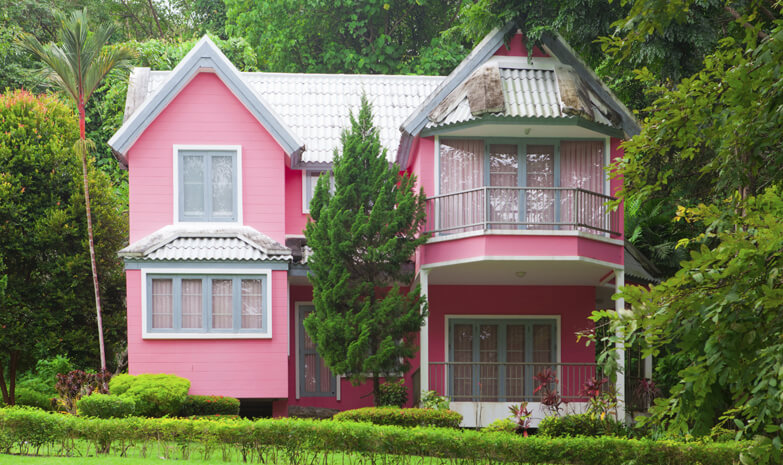We asked real estate agents around the country to share their quirky home sale stories and how they overcame those challenges.
We’ve heard the stories of seemingly unsellable homes. The homes that are said to be haunted or the site of a murder. How about the listings complete with insect or snake infestations? Sometimes, homes are just plain odd. We asked real estate agents around the country to share their quirky home sale stories and how they overcame those challenges.
Priced so low, you forget about the murder
Bruce Ailion, a REALTOR® and attorney with RE/MAX Town and Country Success Real Estate Brokers in Atlanta, remembers one foreclosure with an eerie past. The empty residence housed most of the owners’ furnishings and possessions.
“The owner’s name was in the tax records, but [the] contact was the property address,” Ailion said. “We would typically do an eviction and move the property to the street. We checked with the neighbors. It turns out the husband died in the home from apparent poisoning. His wife was arrested and in jail without bond. The house was foreclosed while she was awaiting trial.”
The solution? Ailion said the asking price was too good to pass up. While he recalls the home’s market value was about $199,900, it sold for about $20,000 less. That was after Ailion told the buyers about the home’s history.
Creativity sells
Real estate agent Ryan Zuckerman, principal of The Zuckerman Group in Coconut Creek, Fla., tells a story not of a quirky home, but an odd buyer. His client’s main goal was to find a house in which she could fit perfectly in the bathtub.
“My client went and sat in every tub, in every house, to make sure she’d fit,” Zuckerman said. “She wouldn’t buy the house if she didn’t fit in the tub. And she was only 5 feet tall.”
The solution? Patience paid off. Zuckerman said it took going to 20 or 30 houses before she found the right tub and bought the house.
Zuckerman also remembers listing a four-bedroom house. The potential buyers were a family of six. The parents each had two children from a previous marriage. The family wanted a bedroom for each of the kids — for a total of five bedrooms.
The solution? “The house had two dining room areas,” Zuckerman said. “The seller actually paid for it and turned one of the dining room areas into a bedroom.”
Use what’s unusual as a selling tool
Ailion, whose clients include banks selling foreclosed homes, said foreclosures often are difficult to sell. But that didn’t stop him from selling an ordinary home on about 10 acres, where the owner had built a 24-stall luxury barn.
“The barn and related riding facilities probably cost $300,000 or more than the house,” Ailion said. “It was spectacular in its opulence.”
The solution? Ailion promoted the home’s unique feature through social media and Internet advertising. His headline: “Opulent 24-stall, bank-owned barn in the heart of metro Atlanta’s horse country with owner’s home included in the sale.”
Three strong potential buyers answered the ads and competed to purchase the property. Two had daughters who owned horses; one was a local riding instructor looking for a facility, Ailion said.
Frank Bernardo, a real estate agent at Pinnacle Estate properties in Encino, Calif., said he sold a house in the Hollywood Hills that was built in 1923. “When you walked into the property, it literally looked like it was from the 1920s, with original fixtures and décor,” he said.
The solution? “I joked with all the agents that I had it intentionally staged 1920s style, and I made sure everyone knew that it was built in the 1920s, and it was standing strong in great condition for its age,” Bernardo said.
Bernardo said he made sure to price the property right and over-exposed its availability. “Exposure is important to begin with, but when it’s unusual, you need to reach out to people who you wouldn’t normally think would buy the property,” he said.
Makeovers sell chronic listings
Josh Myler, residential division director at The Agency in Beverly Hills, Calif., said he helped a homeowner sell a long-term listing. The 1930s Spanish-style home in Hancock Park was eclectic. The colors were off, according to Myler.
“The outside was painted brown, and the inside [was] painted a variety of colors the owner, himself, happened to gravitate toward,” Myler said.
The solution? To cast as wide a net of potential buyers as possible, Myler had the interior and exterior walls painted a brilliant white. This, he said, gave the house not only a new look but also a fresh, almost new feel, bringing the house back to its original glory.
“People often want to feel like they’re buying a piece of history, but also want something that feels new,” Myler said. “Now that we had a crisp new look, it was time to dress it up. The furnishings before were not right, either. Again, they were pieces from the owner’s own collection.”
The owner tried to avoid the cost of staging, but Myler convinced him of the benefits. “We worked together to pick furnishings that complemented the style of the house and gave it a younger, lighter perspective,” he said. “Boom! $50,000 over the asking price.”
The moral of the story? Just because a home has an unusual quality doesn’t mean it won’t sell. Homeowners rely on your training and expertise and work to come up with ways to either play up the quirk and enhance the home’s unique appeal to attract buyers. That’s a win-win-win for everyone involved.





